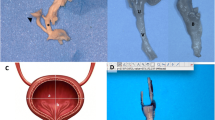Abstract
Purpose and methods
The anal sinuses, small furrows above the pectinate line, sometimes form perianal abscesses in adults. We examined the pattern of fetal growth of the anal sinus and sphincters using 22 mid-term (8–18 weeks) and 6 late-stage (30–38 weeks) fetuses.
Results
In mid-term fetuses, the external and internal sphincters gradually increased in thickness, depending on specimen size (from 0.2 to 1.5 mm), whereas the anteroposterior diameter of the anal canal at the epithelial junction was relatively stable (0.5–1.0 mm) irrespective of specimen size. Anal canal diameter increased less than twofold between mid-term and late-stage fetuses, from 0.5–1.0 to almost 2 mm, whereas sphincter thickness increased over tenfold, from 0.2–1.5 to almost 3.5 mm. The anal sinus often showed balloon-like enlargement when the sphincter muscle bundles were tightly packed in mid-term, but not in late-stage fetuses.
Conclusions
Large concentric mechanical stress from the sphincters in late-stage fetuses apparently prevented the anal sinus from expanding in a balloon-like manner. Conversely, to avoid anal stenosis, the growing sinuses maintained a luminal space of the anal canal in response to stress from rapidly growing sphincters. The inferiorly extending sinus usually provided temporal double canals separated by a thick column. In the presence of double lumens, anal canal duplication is likely to develop without any abnormalities of the anal epithelium and sphincters.







Similar content being viewed by others
References
Williams PL (1995) Gray’s Anatomy, 38th edn. Churchill Livingstone, London, p 1780
Conole FD (1967) The significance of the anal gland in the pathogenesis of anorectal abscess and fistula. Am J Proctol 18:232–238
McColl I (1967) The comparative anatomy and pathology of anal glands. Ann R Coll Surg 40:36–67
Shafik A (1979) A new concept of the anatomy of the anal sphincter mechanism and the physiology of defecation. VI. The central abscess: a new clinicopathologic entity in the genesis of anorectal suppuration. Dis Colon Rectum 22:336–341
Shafer AD, McGlone TP, Flanagan RA (1987) Abnormal crypts of Morgagni: the cause of perianal abscess and fistula-in-ano. J Pediatr Surg 22:203–204
de Vries PA, Friedland GW (1974) The staged sequential development of the anus and rectum in human embryos and fetuses. J Pediatr Surg 9:755–769
Levi AC, Borghi F, Garavoglia M (1991) Development of the anal canal muscles. Dis Colon Rectum 34:262–266
Fröber R, Krebs U, Haas A, Fischer MS, Schier F, Linss W (2001) Three-dimensional reconstruction of the anal striated musculature in a human fetus. Cells Tissues Organs 169:152–157. doi:10.1159/000047873
Kromer P, Korzeniowska-Kromer E (2003) Anal canal development in the embryonic and early foetal period. Folia Morphol 62:285–287
van der Putte SC (2009) The development of the human anorectum. Anat Rec 292:951–954. doi:10.1002/ar.20914
van der Putte SC (1986) Normal and abnormal development of the anorectum. J Pediatr Surg 21:434–440
Kluth D, Hillen M, Lambrecht W (1995) The principle of normal and abnormal hind gut development. J Pediatr Surg 30:1143–1147
Nievelstein RAJ, van der Weref JFA, Verbeek FJ, Valk J, Vermeij-Keers C (1998) Normal and abnormal embryonic development of the anorectum in human embryos. Teratology 57:70–78. doi:10.1002/(SICI)1096-9926(199802)57:2<70::AID-TERA5>3.0.CO;2-A
Fritsch H, Aigner F, Ludwikowski B, Reinstadler-Zankl S, IIlig R, Urbas D, Schwarzer C, Longato S (2007) Epithelial and muscular regionalization of the human developing anorectum. Anat Rec 290:1449–1458. doi:10.1002/ar.20589
Yamaguchi K, Kiyokawa J, Akita K (2008) Developmental process and ectodermal contribution to the anal canal in mice. Ann Anat 190:119–128. doi:10.1016/j.aanat.2007.08.001
Zhang T, Zhang HL, Wang DJ, Tang XB, Jia HM, Bai YZ, Xuan ZW, Wang WL (2011) Normal development pf hindgut and anorectum in human embryo. Int J Colorectal Dis 26:109–116. doi:10.1007/s00384-010-1034-2
Choi SO, Park WH (2003) Anal canal duplication in infants. J Pediatr Surg 38:758–762. doi:10.1016/jpsu.2003.50161
Koga H, Okazaki T, Kato Y, Lane GY, Yamataka A (2010) Anal canal duplication: experience at a single institution and literature review. Pediatr Surg Int 26:985–988. doi:10.1007/s00383-010-2653-y
Narci A, Dilek FH, Cetinkursun S (2010) Anat canal duplication. Eur J Pediatr 169:633–635. doi:10.1007/s00431-009-1094-x
Arakawa T, Hayashi S, Kinugasa Y, Murakami G, Fujimiya M (2010) Development of the external anal sphincter with special reference to intergender difference: observations of mid-term fetuses (15-30 weeks of gestation). Okajimas Folia Anat Jpn 87:49–58. doi:10.2535/ofaj.87.49
Radlanski RJ, Renz H, Klarkowski MC (2003) Prenatal development of the human mandible. 3D reconstructions, morphometry and bone remodeling pattern, sizes 12-117 mm CRL. Anat Embryol 207:221–232. doi:10.1007/s00429-003-0343-4
Murphy F, Puri P, Hutson JM, Holschneider AM (2006) Incidence and frequency of different types, and classification of anorectal malformations. In: Holschneider AM, Hutson JM (eds) Anorectal malformations in children, chapter 8. Springer, Berlin, pp 163–184
Al-Salem AH, Qaisaruddin S, Qureshi SS (1996) Perineal abscess and fistula in ano in infancy and childhood: a clinicopathological study. Pediatr Pathol Lab Med 16:755–764
Arakawa T, Murakami G, Nakajima F, Matsubara A, Ohtsuka A, Goto T, Teramoto T (2004) Morphologies of the interfaces between the levator ani muscle and pelvic viscera, with special reference to muscle insertion into the anorectum in elderly Japanese. Anat Sci Int 79:72–81. doi:10.1111/j.1447-073x.2004.00069.x
van der Putte SC (2006) Anal and ano-urogenital malformations: a histopathological study of “imperforate anus” with a reconstruction of the pathogenesis. Pediatr Dev Pathol 9:280–296. doi:10.2350/06-01-0034.1
Acknowledgments
This study was supported by a grant (0620220-1) from the National R & D Program for Cancer Control, Ministry of Health & Welfare, Republic of Korea.
Author information
Authors and Affiliations
Corresponding author
Ethics declarations
Conflict of interest
The authors declare that they have no conflict of interest.
Rights and permissions
About this article
Cite this article
Arakawa, T., Hwang, S.E., Kim, J.H. et al. Fetal growth of the anal sinus and sphincters, especially in relation to anal anomalies. Int J Colorectal Dis 31, 493–502 (2016). https://doi.org/10.1007/s00384-015-2455-8
Accepted:
Published:
Issue Date:
DOI: https://doi.org/10.1007/s00384-015-2455-8




